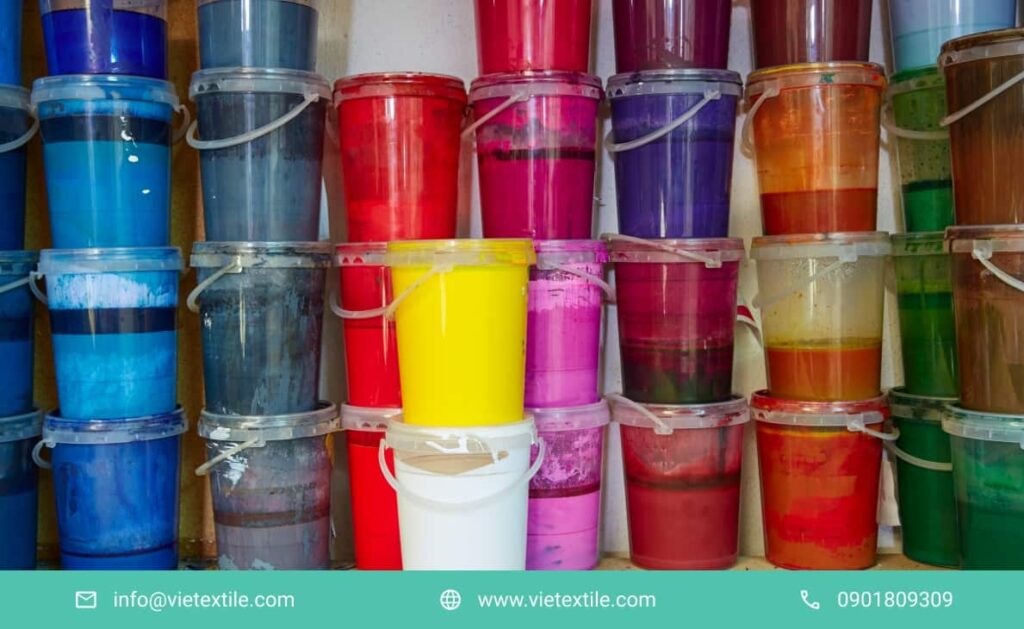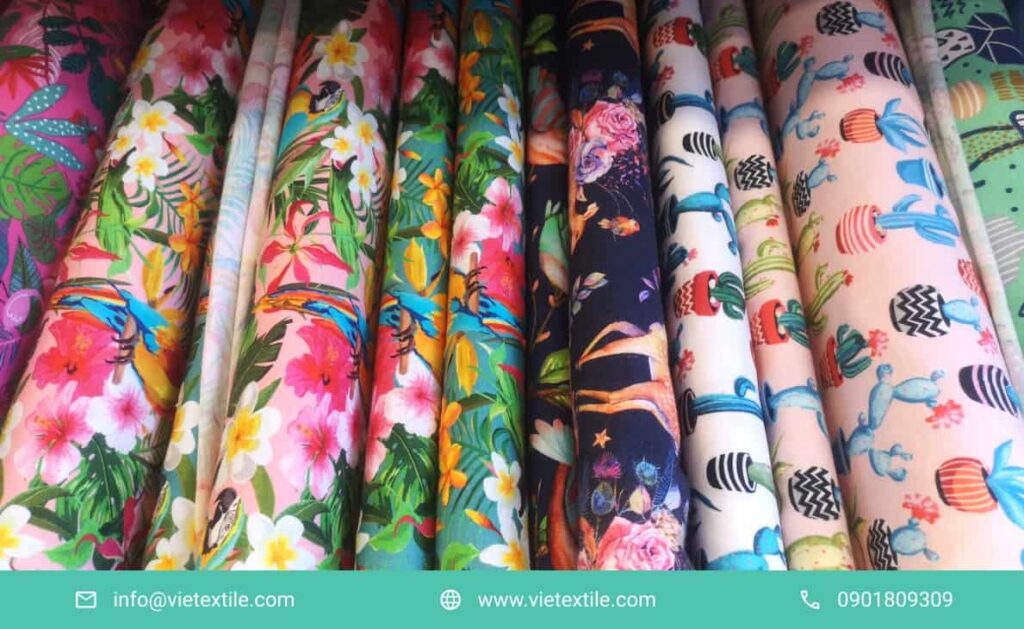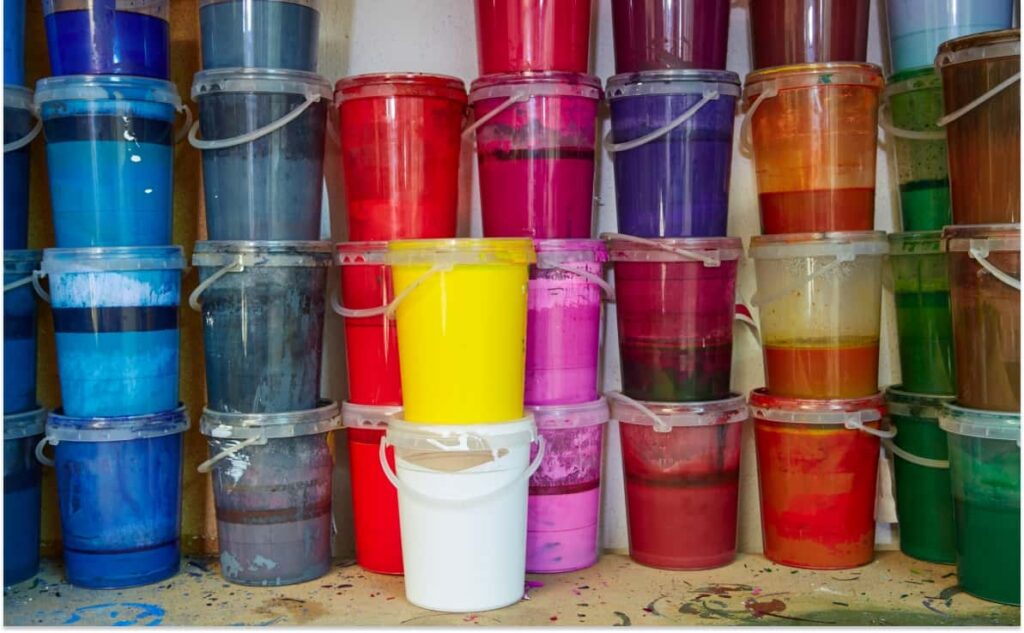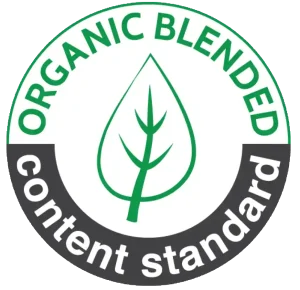Polyester (PES) is the most widely used synthetic fabric in the sportswear, fast fashion, and home goods industries, thanks to its high durability and wrinkle resistance. However, its unique fiber structure demands a stringent requirement for the type of printing ink used. The biggest question manufacturers often ask is: Is polyester textile ink washable? And how can the colors remain vibrant under harsh sunlight?
The answer lies in the specialized ink type: Disperse Ink. This is the only ink capable of deeply penetrating the polyester fiber through the process of sublimation or high-heat fixation. This article will delve into the chemical mechanism of polyester textile ink, analyze in detail the standards for Wash Fastness and Light Fastness, and propose technical solutions to optimize the longevity of the print on PES fabric.

1. Chemical Nature: Why Polyester Must Use Disperse Ink
Nội dung tóm tắt
ToggleThe color fastness of polyester textile ink depends entirely on its ability to bond or deeply permeate the fiber structure. Polyester is a hydrophobic and oleophobic polymer, lacking the hydroxyl (OH) functional groups found in cotton, which prevents common Reactive or Pigment inks from adhering or reacting effectively.
1.1. Polyester Fiber Structure and the Sublimation Bonding Mechanism
Polyester fibers have a dense, nearly non-absorbent molecular structure at room temperature. For the dye to penetrate, high heat must be applied. Polyester textile ink (Disperse type) uses the following mechanism:
- Disperse Dye: These are non-ionized, low molecular weight dye molecules with poor water solubility.
- Sublimation: During the heat pressing process (transfer printing) or steaming (direct printing), the temperature is raised significantly (180*C – 210*C). At this temperature, the solid Disperse dye molecules on the paper (or on the fabric) transition from solid to gas without becoming liquid.
- Fiber Structure Opening: Simultaneously, the high temperature causes the dense polymer structure of the polyester fiber to swell, creating “free space” for the dye vapor to penetrate.
- Color Locking: Upon cooling, the polyester fiber structure contracts, “locking” the Disperse polyester textile ink molecules inside the fiber’s core.
This internal color-locking mechanism creates superior wash and rub fastness.
1.2. Direct Disperse Ink and Steaming Technology
In addition to thermal transfer (Sublimation), polyester textile ink is also used in Direct Disperse printing. Although the dye mechanism remains sublimation and fiber penetration, the process differs:
- Direct Printing: Polyester textile ink is jetted directly onto pre-treated fabric.
- Steaming/Fixation: Instead of heat pressing, the fabric is passed through a steamer or high-temperature dryer (160*C – 180*C) in a humid environment to activate the sublimation and color fixation process.
Direct Disperse polyester textile ink is often preferred for high-stretch fabrics, applications requiring absolute strike-through, or large-volume production, as it eliminates the transfer paper step.
1.3. Differentiating Disperse Ink Lines
Not all Disperse polyester textile inks are created equal. They are categorized based on their sublimation capability and durability:
- Low Energy Disperse Dyes: Require lower temperatures for sublimation, but wash fastness may be inferior.
- High Energy Disperse Dyes (High Fastness): Require higher temperatures (200*C – 210*C), but provide maximum wash and light fastness. High-quality inks often utilize this High Energy line.
2. Wash Fastness of Polyester Textile Ink
Wash fastness is the print’s ability to retain its original color without fading or staining other materials when washed. This is the most crucial criterion in answering the question, “Is polyester ink washable?”
2.1. International Testing Standards (ISO 105-C06 and AATCC 61)
Wash fastness is evaluated using the Grey Scale from 1 (very poor) to 5 (excellent). Common standards include:
- ISO 105-C06: This is a global testing standard that simulates various washing conditions (A1S, A2S, C3S, etc.) with specific temperatures, detergents, and steel balls. For high-quality sportswear, polyester textile ink needs to achieve a level of 4 or higher.
- AATCC 61: A US standard, often used for products exported to the North American market, simulating multiple washing cycles in a short time (e.g., 5 wash cycles).
To achieve a score of 4 or 5, the polyester textile ink must be fully fixed into the fiber, with no residual dye molecules left on the surface.
2.2. Key Technical Factors Affecting Wash Fastness
2.2.1. Temperature and Time of Color Fixation
If the heat press or steaming temperature is too low, or the duration is too short, the sublimation and fiber penetration process will be incomplete. This leaves a large amount of Disperse dye loosely adhering to the surface. This excess dye will be removed during the first wash or post-printing wash-off, leading to poor wash fastness. Uniform temperature control across the entire print surface is critically important.
2.2.2. Back Staining Phenomenon
Back Staining is the phenomenon where unfixed Disperse dye washes out of the fabric and re-dyes the white or light-colored parts of the product itself. This is particularly severe during the post-printing wash-off process (for Direct Disperse).
- Remedy: Use a Dispersing Agent during the post-printing wash-off process to keep excess dye suspended in the wash water, preventing it from re-adhering to the fabric. A professional hot wash-off procedure (60*C – 80*C) is necessary to completely remove unfixed polyester textile ink molecules.
2.2.3. Dye Quality
High-grade polyester textile inks use refined, stable dye molecules with good dispersion, minimizing the formation of insoluble particle clusters. The quality of the dye determines the color depth and the resistance to hydrolysis in the washing environment.
3. Light Fastness and UV Resistance

Light fastness is the ability of polyester textile ink to maintain its color when exposed to sunlight or high-intensity artificial light. This is a critical criterion for swimwear, outdoor sportswear, and curtains.
3.1. Blue Wool Scale Standard ISO 105-B02
Light fastness is measured using the Blue Wool Scale from 1 (very poor) to 8 (excellent).
- ISO 105-B02: This standard compares the color fading of the print sample with 8 standard blue wool patches that have been dyed.
- Required Levels: For most common applications, polyester textile ink needs to achieve level 4-5. For products in direct sunlight (like curtains, outdoor wear), level 6-7 is mandatory.
3.2. Photofading Mechanism
Light (especially UV rays) carries energy that can break the chemical bonds within the dye molecule, causing it to lose its light absorption capacity and leading to fading (Photofading).
- Main Factor: The impact of light on the Chromophore groups (color-bearing groups) in the Disperse dye molecule.
- Remedy: High-quality polyester textile dyes are designed with a more stable molecular structure, capable of absorbing UV energy without being destroyed.
3.3. Influence of Fabric Fiber and UV Absorbers
Polyester fiber itself has better UV resistance than natural fibers. However, to enhance the light fastness of polyester textile ink, the following measures can be used:
- UV Absorbers: These substances are added to the pre-treatment solution or the ink itself to absorb UV rays before they reach the dye molecule, providing better color protection.
- Specific Colors: Dark colors (Black, Navy Blue) usually have higher light fastness than light colors (Yellow, Red, Fluorescent), due to higher dye concentration and better optical energy absorption capacity.
4. Optimizing the Digital Printing Process for Maximum Durability
The durability of polyester textile ink is not only due to ink quality but also the tight control of the printing and post-processing steps.
4.1. Controlling Humidity and Pressure During Heat Pressing/Steaming
Color Fixation is the most critical step:
- Heat Pressing (Sublimation): Pressure must be uniform and sufficient to ensure the transfer paper fully contacts the fabric. Temperature and time must be carefully checked (typically 200*C for 30-45 seconds).
- Steaming (Direct Disperse): Saturated steam (160*C – 180*C) is necessary. High humidity aids the sublimation process, softening the polyester fibers and increasing the penetration capacity of the polyester textile ink molecules.
4.2. The Role of Carriers
Some polyester textile ink systems (especially direct printing) may use a carrier chemical in the pre-treatment solution.
- Mechanism: Carriers help increase the mobility of Disperse dye molecules at the fixation temperature, allowing them to penetrate deeper and faster into the polyester fiber.
- Note: The use of carriers must be strictly controlled because residues can affect the fabric’s hand feel and pose potential environmental risks.
4.3. Print Head and Ink System Cleaning Procedure
Disperse polyester textile ink may contain non-dissolvable particles or crystallized substances after long storage. Clogged print heads not only reduce print quality but also affect the color fixation process (due to uneven ink jetting).
- Ink Filtration: Polyester textile ink must be passed through ultra-fine filters (typically 1-5 microns) before entering the print head.
- Periodic Cleaning: Use specialized cleaning solutions to remove dried Disperse ink sediment from the print head and circulation system. This maintains stable jetting performance, ensuring color uniformity in the printed product.
5. Comparing Color Fastness Between Transfer and Direct Printing
Both methods using Disperse polyester textile ink provide high color fastness, but there are some minor technical differences:
| Criterion | Transfer Printing (Sublimation) | Direct Printing (Direct Disperse) |
| Penetration | Maximum penetration, often used for double-sided fabrics (flags, banners, sportswear). | High penetration, but may be less than Sublimation on thin fabrics. |
| Wash Fastness | Very high, typically level 4-5. Low risk of Back Staining as excess ink remains on the paper. | Very high, typically level 4-5. Requires strict post-printing wash-off to remove excess ink. |
| Light Fastness | Very high, depends on ink quality and fixation temperature. | Very high, comparable to Sublimation. |
| Hand Feel | Excellent, color is inside the fiber. | Excellent, color is inside the fiber. |
Overall, both methods using Disperse polyester textile ink are superior to other printing techniques on PES fabric in terms of color fastness.
6. Resolving Common Issues that Reduce Color Fastness

When the wash or light fastness of polyester textile ink fails to meet requirements, the cause often stems from the process rather than the ink itself.
6.1. Migration Due to Excessive Heat
Polyester can be prone to migration or ‘sublimate out’ if heat pressed at overly high temperatures.
- Phenomenon: The fixed polyester textile ink re-sublimates under the effect of heat (e.g., when ironing or re-pressing a decal) and stains surrounding materials.
- Solution: Control ironing or pressing temperature below 130*C. Use Disperse inks with a high sublimation point (High Energy Disperse Dyes) to minimize this risk.
6.2. The Effect of External Chemicals
Certain chemicals can reduce the color fastness of polyester textile ink:
- Strong Detergents: Detergents containing Chlorine or strong oxidizing agents can break down the dye structure, causing faster fading. Customers should be advised to use mild, bleach-free laundry detergent.
- Acid/Alkaline Environments: Disperse dyes have good pH stability, but overly acidic (e.g., low pH sweat) or highly alkaline environments can alter the color. Use a final wash-off process that achieves a neutral pH (6.5 – 7.5).
6.3. Addressing Rubbing Fastness
Rubbing Fastness (resistance to abrasion) is the ability of the color not to rub off when the fabric is chafed, especially important in sportswear.
- Cause of Reduced Durability: Often due to the polyester textile ink only adhering to the surface (because the fixation temperature was insufficient).
- Solution: Ensure the sublimation process is complete, allowing the dye to fully penetrate the fiber. Direct printing often has better rubbing fastness if the fixation process is optimized.
7. VieTextile: Your Partner for Premium Polyester Textile Ink Solutions
VieTextile is committed to providing high-quality Disperse polyester textile ink solutions, helping customers achieve maximum color fastness according to the most demanding international standards (ISO, AATCC).
We offer High Energy Disperse ink lines, optimized to deliver a vibrant color gamut and superior wash fastness (above level 4) and light fastness (above level 5-6).
VieTextile’s support services include:
- Ink Selection Consulting: Assistance in choosing the right polyester textile ink line for specific PES fabric types (knits, wovens, high-stretch).
- Temperature Calibration: Consulting and calibrating temperature/pressure/time parameters for heat presses and steamers to ensure 100\% color fixation efficiency.
- Additive Solutions: Providing carriers, dispersing agents, and UV absorbers to enhance color fastness for special applications.
With VieTextile, you are not just buying polyester textile ink; you are acquiring a complete technical process that ensures your products can withstand the toughest washing and weather tests.
8. Frequently Asked Questions (FAQ) About Polyester Textile Ink
Q: Can Disperse Polyester Textile Ink be printed on Cotton? A: No. Disperse polyester textile ink is designed to bond with the polymer of PES fiber. It lacks the chemical ability to bond with the cellulose fibers of cotton. If printed on cotton, the ink will only loosely adhere to the surface and be completely washed off in the first laundry cycle.
Q: Which method offers higher wash fastness: Transfer or Direct Printing? A: If executed correctly, both methods using Disperse polyester textile ink provide comparable wash fastness (typically level 4-5). The difference lies in controlling the color fixation process (heat pressing for transfer, steaming for direct).
Q: What is the optimal temperature for fixing Polyester Textile Ink? A: The ideal polyester textile ink fixation temperature for High Energy Disperse ink is approximately 200*C – 210*C for transfer printing, and 160*C – 180*C with humidity for direct printing. Lower temperatures will reduce color fastness.
Q: What does Light Fastness Level 5 on the Blue Wool Scale mean? A: Light fastness level 5 on the Blue Wool Scale (ISO 105-B02) means the print sample has 5 times the resistance to fading when exposed to sunlight compared to the Level 1 standard sample. This is considered a good level and suitable for most normal textile products.
Q: How can I prevent Back Staining when washing? A: This occurs when excess Disperse dye molecules re-adhere to the fabric. To prevent this, a Dispersing Agent must be used in the post-printing wash-off water. This agent helps the excess polyester textile ink molecules remain suspended in the water and be completely rinsed away.
Q: Is Polyester Textile Ink prone to clogging print heads? A: Disperse polyester textile ink, especially the High Energy type, can be more prone to clogging if not stored and filtered correctly. The dye molecules can crystallize or aggregate. An ink circulation system and thorough filtration process are mandatory solutions.
Q: Which ink should be used when printing on Poly-Cotton blends? A: For blended fabrics (e.g., 65% Polyester / 35% Cotton), the optimal solution is to use a Hybrid Ink: a combination of Disperse ink (for the PES portion) and Pigment/Reactive ink (for the Cotton portion), or a specialized Pigment ink for blends with a strong binder.
Q: Does the fabric’s Hand Feel change when using Polyester Textile Ink? A: With Disperse polyester textile ink (both transfer and direct), the color fully penetrates the fiber. Therefore, the hand feel of the fabric is preserved; the fabric remains soft and breathable, without the thick layer of ink film on the surface like screen printing or some Pigment inks.
To elevate your textile product quality and ensure absolute color fastness, contact VieTextile for in-depth consultation on polyester textile ink today!
Contact Information:
Hotline: 0901 809 309
Email: info@vietextile.com
Website: https://vietextile.com










